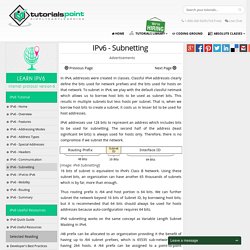

IPv6 Configuration Guide, Cisco IOS Release 15.2M&T - IPv6 Addressing and Basic Connectivity [Support] IPv6 addresses are represented as a series of 16-bit hexadecimal fields separated by colons (:) in the format: x:x:x:x:x:x:x:x.
![IPv6 Configuration Guide, Cisco IOS Release 15.2M&T - IPv6 Addressing and Basic Connectivity [Support]](http://cdn.pearltrees.com/s/pic/th/configuration-connectivity-105383682)
Following are two examples of IPv6 addresses: IPv6 addresses commonly contain successive hexadecimal fields of zeros. Two colons (::) may be used to compress successive hexadecimal fields of zeros at the beginning, middle, or end of an IPv6 address (the colons represent successive hexadecimal fields of zeros). The table below lists compressed IPv6 address formats. A double colon may be used as part of the ipv6-address argument when consecutive 16-bit values are denoted as zero. This documentation has been moved - Implementing DHCP for IPv6 [Support] IPv6 Configuration Guide, Cisco IOS Release 15.2S - IPv6 Unicast Routing [Support] An aggregatable global address is an IPv6 address from the aggregatable global unicast prefix.
![IPv6 Configuration Guide, Cisco IOS Release 15.2S - IPv6 Unicast Routing [Support]](http://cdn.pearltrees.com/s/pic/th/configuration-release-unicast-105376144)
The structure of aggregatable global unicast addresses enables strict aggregation of routing prefixes that limits the number of routing table entries in the global routing table. Aggregatable global addresses are used on links that are aggregated upward through organizations, and eventually to the ISPs. Aggregatable global IPv6 addresses are defined by a global routing prefix, a subnet ID, and an interface ID. Except for addresses that start with binary 000, all global unicast addresses have a 64-bit interface ID. The IPv6 global unicast address allocation uses the range of addresses that start with binary value 001 (2000::/3). Addresses with a prefix of 2000::/3 (001) through E000::/3 (111) are required to have 64-bit interface identifiers in the extended universal identifier (EUI)-64 format. An interface ID is used to identify interfaces on a link.
IPv6 Configuration Guide, Cisco IOS Release 15.1S - Implementing IPv6 Addressing and Basic Connectivity [Cisco IOS 15.1S] A value of 135 in the Type field of the ICMP packet header identifies a neighbor solicitation message.
![IPv6 Configuration Guide, Cisco IOS Release 15.1S - Implementing IPv6 Addressing and Basic Connectivity [Cisco IOS 15.1S]](http://cdn.pearltrees.com/s/pic/th/configuration-implementing-105383597)
Neighbor solicitation messages are sent on the local link when a node wants to determine the link-layer address of another node on the same local link (see the figure below). When a node wants to determine the link-layer address of another node, the source address in a neighbor solicitation message is the IPv6 address of the node sending the neighbor solicitation message. The destination address in the neighbor solicitation message is the solicited-node multicast address that corresponds to the IPv6 address of the destination node. IPv6 Subnetting. In IPv4, addresses were created in classes.

Classful IPv4 addresses clearly define the bits used for network prefixes and the bits used for hosts on that network. To subnet in IPv4, we play with the default classful netmask which allows us to borrow host bits to be used as subnet bits. This results in multiple subnets but less hosts per subnet. That is, when we borrow host bits to create a subnet, it costs us in lesser bit to be used for host addresses. IPv6 addresses use 128 bits to represent an address which includes bits to be used for subnetting. 16 bits of subnet is equivalent to IPv4’s Class B Network. Thus routing prefix is /64 and host portion is 64 bits. IPv6 subnetting works on the same concept as Variable Length Subnet Masking in IPv4. /48 prefix can be allocated to an organization providing it the benefit of having up to /64 subnet prefixes, which is 65535 sub-networks, each having 264 hosts. IPv6 Tutorial. Internet Protocol version 6 (IPv6) is the latest revision of the Internet Protocol (IP) and the first version of the protocol to be widely deployed.

IPv6 was developed by the Internet Engineering Task Force (IETF) to deal with the long-anticipated problem of IPv4 address exhaustion. This tutorial will help you in understanding IPv6 and its associated terminologies along with appropriate references and examples. This tutorial has been designed to help beginners understand the basic concepts of IPv6 required to work with any TCP/IP based protocols. After completing this tutorial you will find yourself at a moderate level of expertise of IPv6 from where you can take yourself to next levels. Before you start proceeding with this tutorial, we are assuming that you are already aware of basic computer and network concepts such as what is a protocol, why do we need protocol, network layers, etc.
Tutorial: IPv6 Basics.